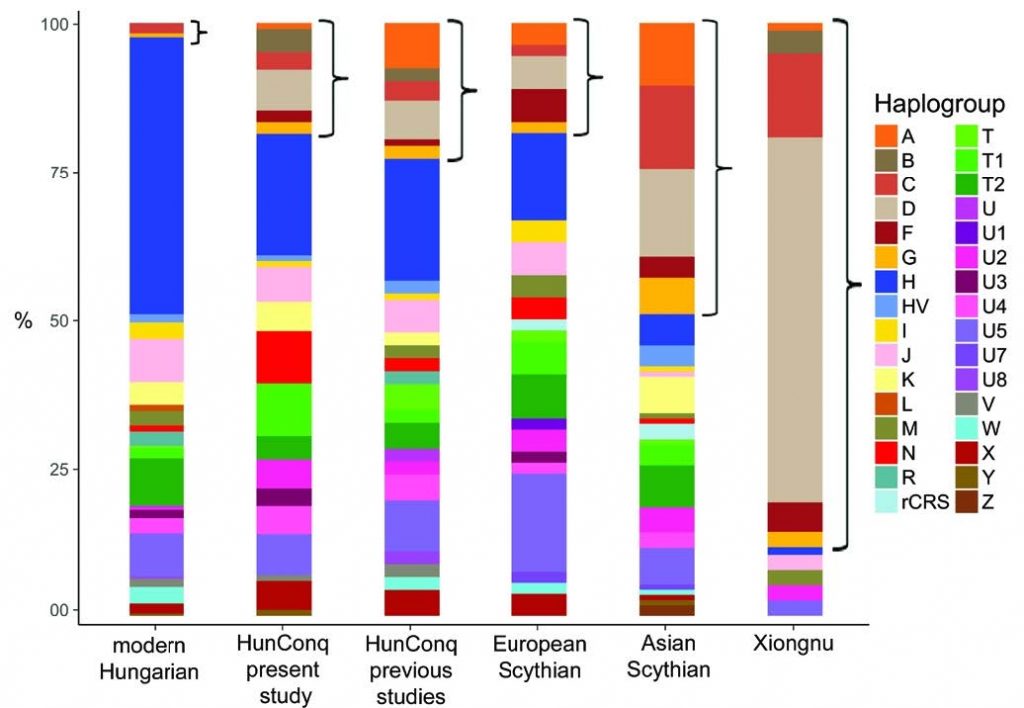New preprint at BioRxiv, Mitogenomic data indicate admixture components of Asian Hun and Srubnaya origin in the Hungarian Conquerors, by Neparáczki et al. (2018), at BioRxiv.
Abstract (emphasis mine):
It has been widely accepted that the Finno-Ugric Hungarian language, originated from proto Uralic people, was brought into the Carpathian Basin by the Hungarian Conquerors. From the middle of the 19th century this view prevailed against the deep-rooted Hungarian Hun tradition, maintained in folk memory as well as in Hungarian and foreign written medieval sources, which claimed that Hungarians were kinsfolk of the Huns. In order to shed light on the genetic origin of the Conquerors we sequenced 102 mitogenomes from early Conqueror cemeteries and compared them to sequences of all available databases. We applied novel population genetic algorithms, named Shared Haplogroup Distance and MITOMIX, to reveal past admixture of maternal lineages. Phylogenetic and population genetic analysis indicated that more than one third of the Conqueror maternal lineages were derived from Central-Inner Asia and their most probable ultimate sources were the Asian Huns. The rest of the lineages most likely originated from the Bronze Age Potapovka-Poltavka-Srubnaya cultures of the Pontic-Caspian steppe, which area was part of the later European Hun empire. Our data give support to the Hungarian Hun tradition and provides indirect evidence for the genetic connection between Asian and European Huns. Available data imply that the Conquerors did not have a major contribution to the gene pool of the Carpathian Basin, raising doubts about the Conqueror origin of Hungarian language.

Just recently another article contributed to a similar idea. I already talked about the Bronze Age R1a-z93 sample with high steppe ancestry found in the Balkans, and its likely origin in an expansion of the Srubna or a related culture. No truce, therefore, for those looking for autochthonous continuity anywhere in Europe.
We are seeing how multiple migrations shaped the history of the Carpathian basin (and its complex genetic structure) – and of Europe in general -, often from the Pontic-Caspian steppe. That is clear from many different prehistorical and historical times, such as the expansions of Suvorovo-Novodanilovka, Yamna, Srubna, Thraco-Cimmerians, Sarmatians, Scythians, Huns,…
About the linguistic interpretations based on genetics contained in the paper (Hungarian language as a legacy of Huns), well, you know my stance regarding the Yamnaya ancestral concept (and the wrong linguistic interpretations derived from it, which many sadly keep to this day), and genetics in general to solve language questions…
This is yet another example of how (what some people would call) “scientific data” is useless without sound anthropological models.
Featured image, from the article: “Hypothetic origin and migration route of different components of the Hungarian Conquerors. Bluish line frames the Eurasian steppe zone, within which all presumptive ancestors of the Conquerors were found. Yellow area designates the Xiongnu Empire at its zenith from which area the East Eurasian lineages originated. Phylogeographical distribution of modern East Eurasian sequence matches (Fig. 1) well correspond to this territory, especially considering that Yakuts, Evenks and Evens lived more south in the past [108], and European Tatars also originated from this area. Regions where Asian and European Scythian remains were found are labeled green, pink is the presumptive range of the Srubnaya culture. Migrants of Xiongnu origin most likely incorporated descendants of these groups. The map was created using QGIS 2.18.4[109]”.
Article available under a CC-BY-NC-ND 4.0 International license.
Discovered via Razib Khan.
See also:
- Modern Hungarian mtDNA more similar to ancient Europeans than to Hungarian conquerors
- The concept of “Outlier” in Human Ancestry (II): Early Khvalynsk, Sredni Stog, West Yamna, Iron Age Bulgaria, Potapovka, Andronovo…
- Expansion of peoples associated with spread of haplogroups: Mongols and C3*-F3918, Arabs and E-M183 (M81)
- Human ancestry solves language questions? New admixture citebait
- The Great Hungarian Plain in a time of change in the Balkans – Neolithic, Chalcolithic, and Bronze Age
- Science and Archaeology (Humanities): collaboration or confrontation?
- Massive Migrations? The Impact of Recent aDNA Studies on our View of Third Millennium Europe